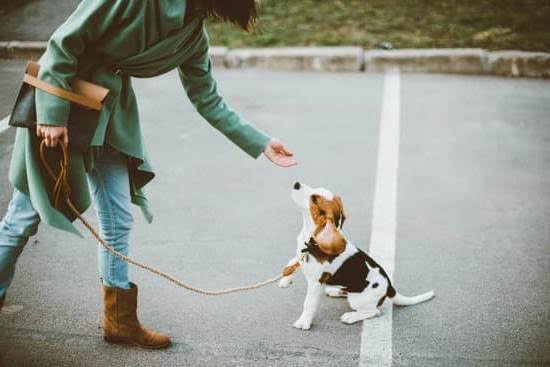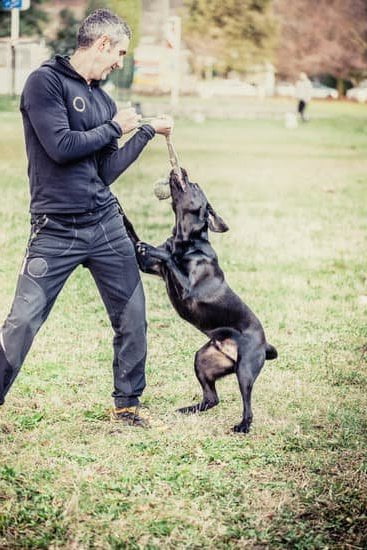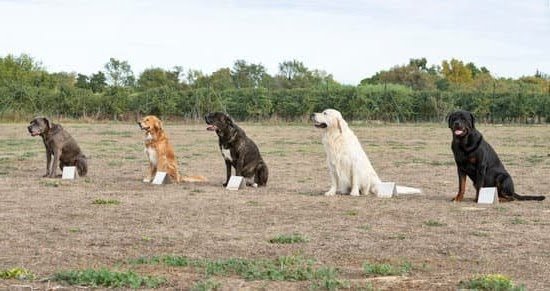Training is an essential aspect of owning a dog, as it helps establish boundaries and ensures their safety and wellbeing. A well-trained dog is more likely to be confident, obedient, and responsive to commands, making them better companions and contributing members of society.
One question that often arises when it comes to training dogs is whether yard fences are sufficient for this purpose. In this article, we will explore the pros and cons of using yard fences as a training tool for dogs, as well as the importance of incorporating other techniques alongside them.
Setting boundaries for dogs is crucial in order to prevent them from wandering into potentially dangerous situations or causing harm to themselves or others. Proper training allows owners to establish these boundaries effectively and helps dogs understand what is expected of them. Training also plays a pivotal role in socializing dogs with humans and other animals, reducing anxiety and aggressive behavior. Without proper training, the risk of potential accidents, conflicts, or injuries increases significantly.
There are various approaches to training dogs that can be utilized depending on personal preferences and the needs of individual dogs. Traditional methods involving punishment or dominance have been used for many years but are increasingly being replaced by positive reinforcement techniques such as reward-based training or clicker training.
These modern approaches focus on reinforcing desired behaviors rather than punishing unwanted ones. It is important to consider different training methods when deciding how to incorporate yard fences into your dog’s overall training plan.
While yard fences can be a valuable tool in dog training, they have both advantages and limitations. On one hand, they provide a physical barrier that can help contain your dog within a specific area and prevent potential dangers or escapes. Yard fences also enable owners to control access to certain parts of the property or restrict interactions with external factors like neighboring pets or wildlife.
However, relying solely on yard fences may not address all aspects of training needed for dogs. They may not teach dogs to respond to commands beyond the boundaries of the yard, and some dogs may find ways to escape or become anxious or frustrated when confined.
Different Approaches to Training Dogs
Training dogs is an essential part of their upbringing, ensuring their safety and well-being. There are different approaches to training dogs, each with its own advantages and disadvantages. It is important for dog owners to understand these approaches in order to choose the most effective method for their furry friends.
One popular approach to dog training is positive reinforcement, which involves rewarding desired behaviors with treats or praise. This method focuses on motivating the dog through positive associations and encourages them to learn and repeat behaviors that are rewarded.
Another method is clicker training, where a clicker is used to mark desired behaviors, followed by a reward. This technique helps dogs associate the sound of the clicker with a reward, making it easier for them to understand what behavior is being reinforced.
Traditional training techniques, such as dominance-based or punishment-based methods, have been widely used in the past but are now considered outdated. These methods rely on using fear or force to gain control over the dog’s behavior. Modern approaches emphasize building a strong bond and relationship with the dog through trust and cooperation.
In order to determine which approach is most suitable for their specific needs, dog owners should consider factors such as their dog’s temperament, age, and any behavioral issues they may be dealing with. It may also be beneficial to consult with a professional dog trainer who can provide guidance and expertise in choosing the right training method.
| Approach | Advantages | Disadvantages |
|---|---|---|
| Positive Reinforcement | – Motivates dogs through rewards\n – Builds a positive association with desired behaviors | – May not be effective for all dogs\n – Requires consistency and patience |
| Clicker Training | – Provides clear communication with the dog\n – Helps dogs understand which behavior is being rewarded | – Requires proper timing and coordination\n – Can be difficult for some dog owners to master |
| Traditional Training | – Can provide quick results in certain cases\n – May be familiar to dog owners who grew up with these methods | – Can cause fear or aggression in dogs\n – Does not build a trusting bond between owner and dog |
Pros and Cons of Yard Fences in Dog Training
Yard fences can be a valuable tool in dog training, but like any training method, they have their pros and cons. In this section, we will discuss the advantages of utilizing yard fences for dog training purposes as well as the potential drawbacks or limitations of relying solely on yard fences.
One of the biggest advantages of using yard fences in dog training is that they provide a physical barrier that helps establish boundaries for dogs. Dogs are natural explorers and can easily be excited or distracted by things outside the boundaries of their property. Yard fences help keep them contained and prevent them from running off or getting into potentially dangerous situations.
In addition to keeping dogs safe, yard fences also allow for off-leash training in a controlled environment. This gives dogs more freedom to explore and play while still being within the confines of their designated area. With proper training, dogs can learn to understand and respect the boundaries set by the fence, which can contribute to their overall safety and wellbeing.
However, there are some potential drawbacks or limitations to consider when relying solely on yard fences for dog training. For example, some experts argue that using only a physical barrier may not address underlying behavioral issues or provide enough mental stimulation for dogs. Dogs may become bored or frustrated if left unsupervised in a fenced yard for extended periods without additional mental and physical exercise.
Moreover, it’s important to recognize that while yard fences can be effective at containing dogs within a specific area, they do not guarantee complete protection from outside elements or distractions. For instance, some dogs may be prone to digging under or jumping over fences if not properly trained or supervised. Additionally, certain breeds with high prey drives may still become fixated on external stimuli such as squirrels or other animals when inside the fenced area.
It is evident that there are both benefits and considerations when it comes to using yard fences for dog training. While they provide containment and safety benefits, it is crucial to supplement this training method with additional mental stimulation and exercise to ensure a well-rounded training experience for your furry friend.
Choosing the Right Fence for Dog Training
When it comes to dog training, choosing the right fence for your yard is crucial. A yard fence serves as a valuable tool in setting boundaries for your furry friend, ensuring their safety and wellbeing. There are different types of fences available, each with its own set of advantages and disadvantages. Evaluating these options and understanding their suitability for training purposes is essential.
One important factor to consider when selecting a fence for dog training is the height. The fence should be tall enough to prevent your dog from jumping over or climbing through it. This is especially important if you have a larger breed or an energetic dog who might be more prone to testing boundaries.
Additionally, the material of the fence is also important. Some dogs may try to dig under wooden or chain-link fences, so opting for materials like vinyl or aluminum can help prevent escape attempts.
Another aspect to consider is the visibility of the fence. A solid fence may provide privacy, but it can hinder your dog from seeing what’s on the other side, which can cause frustration and potentially lead to behavioral issues. On the other hand, semi-transparent fences like picket fences or wire fences allow dogs to see through and remain aware of their surroundings.
In addition to choosing the right type of fence, it’s essential to ensure that your dog understands and respects its boundaries. Yard fences should never be relied upon as the sole method of training. Complementary training techniques such as positive reinforcement and commands play a crucial role in reinforcing boundary awareness. Teaching your dog basic commands like “stay” or “leave it” can further enhance their understanding of where they are allowed to go within the yard.
By carefully considering factors such as fence height, material, visibility, and combining them with effective training techniques, you can create an environment that fosters successful dog training outcomes using yard fences. It’s important to remember that yard fences should be seen as a part of a holistic approach to training, and that ongoing consistency, reinforcement, and supervision are key to maintaining the boundaries established by the fence.
Training Techniques to Complement Yard Fences
Yard fences can be a valuable tool in training dogs and setting boundaries. However, they should not be relied upon solely for effective training. To ensure the best results, it is important to complement yard fences with other training techniques that reinforce boundary awareness. Here are some additional training techniques that can support the effectiveness of yard fences:
- Recall Training: Teaching your dog reliable recall commands is crucial for maintaining safety and control, even within the confines of a fenced yard. Practice calling your dog back to you using positive reinforcement techniques. Start by rewarding them with treats or praise every time they come to you when called, gradually reducing the frequency of rewards as they become more proficient.
- Exercise and Mental Stimulation: Dogs need regular exercise and mental stimulation to prevent boredom and unwanted behaviors like excessive barking or digging under fences. Incorporate daily walks, interactive toys, puzzle feeders, and obedience training sessions into your dog’s routine.
- Boundary Reinforcement Exercises: Beyond relying solely on physical barriers like yard fences, reinforcing your dog’s understanding of boundaries through specific exercises can be beneficial. One technique is to use boundary flags or markers placed at set distances from the fence line. Teach your dog to stop and turn back when they approach these markers by using positive reinforcement and redirecting them away from the boundary.
- Obedience Training: Comprehensive obedience training provides dogs with a strong foundation for behavior management. Use positive reinforcement methods to teach basic commands such as sit, stay, leave it, and heel. These commands help establish impulse control and reinforce your role as the leader.
By incorporating these training techniques alongside yard fences, you enhance your dog’s understanding of boundaries both inside and outside the fenced area. Remember that consistency is key in dog training, so be sure to practice these techniques regularly for optimal results.
Common Challenges in Training Dogs with Yard Fences
Training dogs using yard fences can come with its own set of challenges. While yard fences provide a physical boundary for dogs and can be an effective tool in training, there are certain common issues that dog owners may encounter. Understanding these challenges and having strategies to overcome them is essential for successful dog training.
One common challenge when using yard fences for dog training is the temptation for dogs to escape or jump over the fence. Some breeds are natural escape artists and may try to find ways to get out of the yard, especially if they see something interesting outside. This can be frustrating for dog owners who want to ensure their pet’s safety and prevent them from running loose in the neighborhood.
To address this challenge, dog owners can employ reinforcement techniques to teach their dogs that staying within the boundaries of the yard is rewarding. Positive reinforcement, such as treats or praise, can help reinforce good behavior when the dog remains inside the fence. Consistency is key in this aspect of training.
Another common challenge is overcoming distractions or triggers that may cause a dog to become anxious or reactive near the fence line. This could include things like other animals passing by, people walking on the sidewalk, or loud noises from nearby construction. When faced with these distractions, some dogs may bark excessively, lunge at the fence, or display aggressive behavior.
To counteract these reactions, it’s important to desensitize the dog through gradual exposure and positive reinforcement. Start by introducing mild distractions while ensuring that your canine companion remains calm and focused on you rather than fixating on external factors. Over time, slowly increase the level of difficulty by introducing more challenging stimuli while rewarding calm behavior.
Training dogs using yard fences can have its share of challenges but with patience and consistent effort, many obstacles can be overcome. By addressing issues such as escaping tendencies and managing distractions near the fence line head-on through appropriate training techniques, pet parents can create a safe and secure environment for their furry friends to enjoy.
Alternatives to Yard Fences for Training Dogs
Leash Training
Leash training is an effective alternative to yard fences for training dogs, especially if you don’t have a yard or if the yard is not suitable for fencing. It involves teaching your dog to walk on a leash and obey commands while on a walk outside. Leash training helps dogs learn to stay within certain boundaries and prevents them from running off or approaching potentially dangerous situations.
Start by using a well-fitted harness or collar and a sturdy leash. Practice walking your dog on the leash in a controlled environment such as a quiet street or park, gradually increasing distractions as your dog becomes more comfortable. Use positive reinforcement techniques such as treats and praise to reward good behavior, and be patient and consistent with your training.
Invisible Dog Fences
Invisible dog fences are another option for training dogs without physical yard fences. These systems consist of an underground wire that emits a signal to a receiver collar worn by the dog. When the dog approaches the boundary line, the receiver collar emits an audible warning sound or mild static correction, serving as a deterrent.
Invisible dog fences can be installed underground or above ground, depending on your preference and needs. However, it’s important to note that invisible dog fences should never be used as the sole method of containment for dogs prone to escaping or those with high prey drives. They work best when combined with proper training techniques to teach dogs about boundaries and reinforce obedience.
Supervised Outdoor Areas
If installing yard fences is not feasible, creating supervised outdoor areas can provide an alternative solution for training dogs. These areas are specifically designed and designated for safe play and exercise purposes without the need for physical barriers like fences. Choose an area with appropriate boundaries where you can closely monitor your dog’s activities and ensure their safety at all times.
Supervised outdoor areas may include playpens with tall sides or portable fencing systems that can be easily set up and taken down as needed. When using supervised outdoor areas, it’s crucial to actively engage with your dog, provide mental and physical stimulation, and reinforce boundaries through consistent training.
Understanding the Limitations of Yard Fences in Training
The Need for Continued Training
While yard fences can be an effective tool for training dogs and keeping them safe within their designated boundaries, it is important to understand their limitations. Yard fences alone should not be seen as a substitute for ongoing training and reinforcement. Dogs are intelligent animals with diverse personalities, and relying solely on physical barriers may not address their individual needs and behavioral challenges.
The Importance of Consistency and Reinforcement
A key limitation of using yard fences in dog training is the need for consistency and reinforcement. Even with a well-constructed fence, dogs may still test its boundaries or attempt to escape if they are not consistently reinforced with appropriate training techniques. It is crucial to develop a consistent routine that combines both physical barriers and positive reinforcement training methods to establish clear boundaries and reinforce desired behaviors.
Ongoing Supervision
Another limitation of yard fences is the potential for dogs to become bored or anxious when left alone outdoors for extended periods. While a fence can provide some freedom and security, it cannot replace the need for regular human interaction and supervision. Dogs thrive on social interaction, mental stimulation, and physical exercise, which cannot always be provided by a stationary fence. Therefore, it is essential to incorporate regular supervised outdoor activities beyond the confines of the yard.
Conclusion
In conclusion, yard fences can be a valuable tool in dog training when used in conjunction with other training techniques. Setting boundaries for dogs is crucial for their safety and wellbeing, and proper training plays a pivotal role in achieving this. While yard fences offer numerous advantages, such as providing a physical barrier and allowing dogs to have outdoor playtime, it is important to acknowledge their limitations.
When choosing the right fence for dog training, factors such as height, material, and visibility should be taken into consideration. It is also important to explore additional training techniques that can support the effectiveness of yard fences. Commands and exercises that reinforce boundary awareness can further enhance the dog’s understanding of their limits.
However, it is essential to understand that yard fences alone are not a substitute for ongoing training and supervision. Challenges may arise during the training process, but with patience and consistency, they can be overcome. Alternatives to yard fences, such as leash training or invisible dog fences, can be considered if yard fences are not feasible.
Frequently Asked Questions
Can you train a dog to stay in an unfenced yard?
It is possible to train a dog to stay in an unfenced yard, but it requires consistent and patient training. Dogs are naturally curious and may be tempted to explore beyond the boundaries of the yard, so teaching them to understand their limits is crucial. This can be achieved through positive reinforcement training methods, such as using treats or praise to reward the dog for staying within the designated area.
Additionally, regular supervision and providing mental stimulation are essential to keep the dog engaged and less likely to wander off. However, it’s important to note that some dogs may have a stronger instinct to roam or may be easily distracted, making it more challenging for them to stay within an unfenced yard.
Should you introduce dogs through a fence?
Introducing dogs through a fence can be beneficial in certain situations, as it allows them to become familiar with each other while remaining physically separated. This method can help assess their reactions and temperament before direct contact, reducing the risk of potential conflicts or aggressive behavior.
By introducing dogs through a fence, they have an opportunity to observe each other’s body language and communicate without the pressure of immediate interaction. However, while this method offers initial safety precautions, it cannot replace proper socialization under controlled circumstances once both dogs have been properly introduced.
What are the negatives of an invisible fence?
Although invisible fences can seem like an attractive option for keeping dogs contained within a specific area without constructing physical barriers, there are several negatives associated with this containment system. Firstly, invisible fences rely on electric shocks or vibrations delivered through a collar worn by the dog when they approach the boundary line. This inflicts discomfort on the animal and can cause stress or anxiety over time if not utilized appropriately.
Furthermore, invisible fences do not prevent other animals or individuals from entering your property, potentially exposing your dog to external threats or distractions that could lead them astray. Moreover, some determined dogs may disregard the shock if they are highly motivated by something outside their boundary line, increasing the risk of running away or getting lost. Finally, an invisible fence does not prevent dogs from being targeted by other animals or from being stolen.

Welcome to the blog! I am a professional dog trainer and have been working with dogs for many years. In this blog, I will be discussing various topics related to dog training, including tips, tricks, and advice. I hope you find this information helpful and informative. Thanks for reading!





